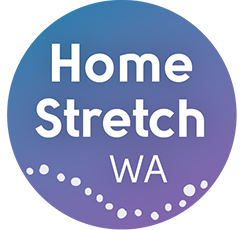Key elements of the Home Stretch WA Model
Home Stretch WA provides support to young people leaving care from 17 ½ to 21 years. The Home Stretch WA Model integrates a range of practice approaches, resources and tools that have been co-designed, tested and refined with young people and Aboriginal Community.
Whilst the model describes how a Home Stretch WA service is delivered, the needs of each young person are always placed at the centre of a persistent, consistent, culturally strong, hope inducing relationship with a skilled and trained Transition Coach.
The model offers young people choice, control and agency in how they engage with the service, whilst guaranteeing access to support and resources to the age of 21. Home Stretch WA is designed to be flexible and individualised, and provide continuity and certainty during a critical transition period.
The Transition Coach Practice Principles describe how Coaches work and the Home Stretch WA Model Integrity Framework provides more information on the service standards for Home Stretch WA providers.
See the Practice Resources section for more information on each of the elements listed below and to access supporting practice guidelines and resources.
Home Stretch WA Model

Young people are at the centre of support. Everyone is treated as an individual.

Support or connection is offered in all areas of life.

Support is delivered in specific ways (practice approaches) that work for young people.

Home Stretch WA focuses on three key elements of support.

Home Stretch WA’s greater purpose is to connect young people with their community and culture.
1. Transition Support
Transition Support is a key element of the Home Stretch program. Flexible, one-to-one support focused on encouraging towards interdependence This support is offered in two main ways:
- Smooth Transition Working together with a young person and their support circle from age of 17.5 years to ensure a smooth transition into the Home Stretch WA program and a seamless continuation of support until the age of 21 years. It’s also about young people being aware of their rights and being able to independently access support they are entitled to after 21.
- Transition Coaches A consistent, persistent and skilled youth worker who works with young people to provide flexible, one to one support focussed on coaching towards independence. The Transition Coach works from a set of practice principles ensuring support provided is consistent and focused on building a young person’s self-reliance, skills, capacity and connection to community, culture and country.
2. Safety Net
The right to a visible, accessible and secure financial safety net that ensures access to housing, foster care, health, education and life skills. This is provided through three different Home Stretch WA service offers:
- Housing Allowance Young people can be supported to access a Housing Allowance that can assist them to afford a broader range of living arrangements and includes an emphasis on providing them the skills and supports they need to secure and maintain safe and stable housing.
- Staying On Agreement Young people can be supported to continue ‘staying on’ with a carer to ensure they have a stable living arrangement until age of 21. This includes a continuation of payments and support to foster and family carers with an expectation that a young person will contribute to their living expenses from their independent income.
- Invest In Me Gives young people the ‘right’ to a visible and secure financial safety net for resources to support them towards their aspirations and goals, or for crisis relief. It provides young people with fast access to financial assistance without having to return to a District Office. There is an expectation that young people will contribute (chip-in) to build their independence, but this isn’t always financial.
3. Support Circles
- Footprints: Walking alongside young people to help them understand and explore the people, places and connections that are important to them. Mapping out the footprints and parts of their life story, we hope to find opportunities for them to build new connections or revisit old ones.
- Pathways: Walking alongside young people as they navigate their connections to family, community, culture and country. Providing the resources and supports they need to heal and connect when they are ready. Coaching young people in the skills and knowledge they need to build their support circles, encouraging them to explore pathways to reconnect and providing a safety net for them if things don’t work out how they had first intended



